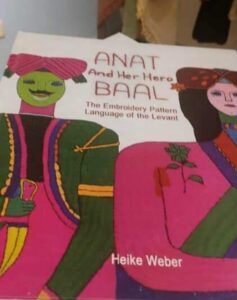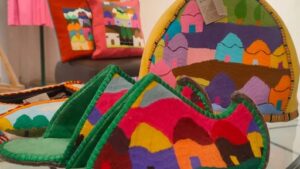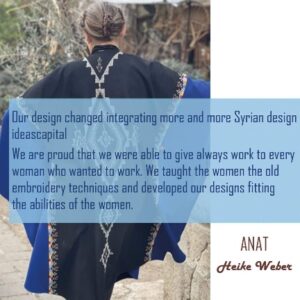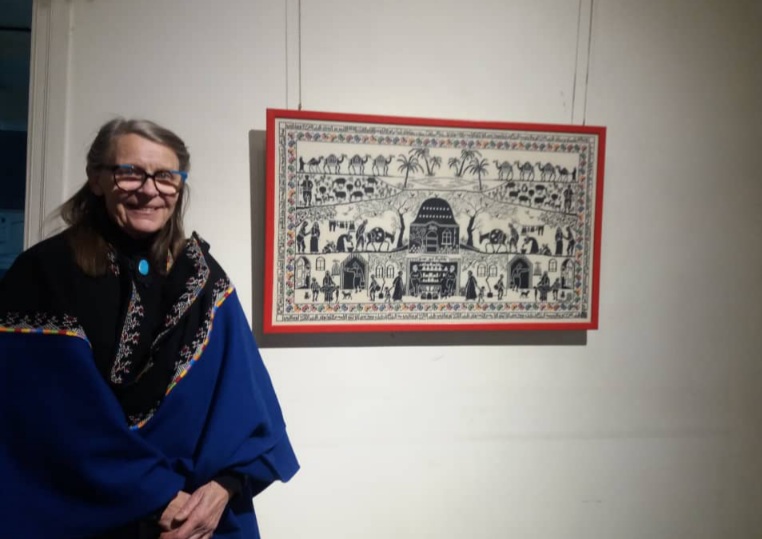German Heike Weber: Syrian embroidery is popular heritage reflecting story and identity of the country
On the occasion of Women’s Day and Mother’s Day and in celebration of heritage, the German Heike Weber holds in Zawaya Gallery in Damascus her exhibition that contains traditional clothes embroidered with different stitches from various regions in Syria.
“I believe that it is important to focus on heritage as Syria has a rich heritage that includes embroidery, life style, cooking, how people greet each other…..Today, the situation in Syria is very difficult and a lot of people were forced to leave the country because of the war in it; therefore it is important to preserve national identity and the unity of people …. I hold such exhibitions to focus on this point….I always talk about how the Palestinian people used their heritage in a smart way for economic reasons through creating job opportunities and selling their products to Gulf States. This way gave them a chance to tell the world that this is our heritage.. …. We have to build relations with Syrians abroad to do the same thing,” Mrs. Weber told Syria Times e-newspaper during a 35-minute- interview with her in the gallery.

In 2021, Mrs. Weber published her book entitled “Anat and her hero Baal” in which she makes a comparison between the traditional embroidery patterns of the Levant and the early patterns of humankind in the eastern Mediterranean and the Near East region.
The book studies how a symbol is the result of a conscious and intense philosophical process of analysis and deep understanding.
“In a symbolic pattern we can express a very complex meaning comprehended in a simple design….Human socialization and education make this simple design or pattern understandable for everybody as a symbol that embodies the analysis of a complex meaning….As such symbols and rituals were necessary to create a united human society. Embroidering these symbolic patterns develops the personality, artistic and technical abilities, creates identity, and a cultural home…. Losing this practice means up-rooting. Heike Weber concludes that the old symbolic patterns, which express a philosophy of life, survived in folkloric practice over the millenniums,” she says in her book.
The 73-old-year woman told us: “ In the past, people were sharing civilizations for more than thousands of years, but now there is a hegemony of one civilization over the other. For example, when TV reports broadcast programs on US or western life styles, peoples in other countries think that the US and the West are developed country… Yes, they are developed countries but they reached this level of development through exploiting the peoples of other countries… So, you can see that some people abandon their heritage and use the ideas of the West.”
She went on to say: “When I went to Jabal Al-Hass in south- east Aleppo province for the first time, I saw the residents drawing and then embroidering their artworks.. They mistakenly believed that they had to embroider Mickey Mouse instead of houses, camel or mosque to be like the west.
There must be an interest in heritage to raise the moral of the people, according to Mrs. Weber, who clarified that the technique of embroidery in Syria has an outstanding verity as there are a lot of stitches.

“For example, in the north of Syria, there is stitch called “Bukhara” stitch, which is derived from Bukhara and it reached in Syria around 2000 years ago through the Silk Road. But later, the Syrian women developed this stitch to be within the heritage of the region….. Another pattern of stitch is called ‘Milan’ stitch and it came from Italy. It is a handmade lace and it was developed in a way that it difference from the Italian way,” she added.
The German woman, who has worked to better the lives of a lot of Syrian and Palestinian women by providing work in embroidery, weaving and dress design, asserted that the condition of working today is very difficult due to the prolonged power outage that hinders the work of women in embroidery besides the western sanctions that hamper obtain8ng raw materials
“This winter , we had an order but we could not deliver it on time because women in rural areas could not finish the work as a result of not having electricity in the evening. Moreover, some of embroidery works exist in houses cracked in the earthquake that hit the country on the 6th of last month and we could not enter the houses to take the artworks….. We also suffer from disability to obtain raw materials due to the sanctions being imposed on Syria…. In the past , we were importing DMC embroidery threads from France at $1/ ball thread. But now the price is $2.5 / ball thread as we can not buy this material directly to Syria… Sanctions, has bad effects on people and their work. The sanctions must be lifted .. Syrians do not need aid from any one because their country is rich with resources,” Mrs. Weber said.
In 1988 she decided to launch a project named “Anat” – after the ancient Semitic Earth mother who battled death- to provide women with an income. She wanted to make something out of nothing. She started with $200. She set up shop near the Omayyad mosque in the Old City. She could not pay the women who made the artworks. So she went to Germany to sell what they made.”
1000 women were working in her “Anat” project, whose products were sold to foreign tourists and restaurants . But this number reduced to 50 ones after the start of the war in the country in 2011.
 “A lot of women want to work in embroidery field, but we can not employ them because there is no promotion of products… I was demanded to train refugees in Lebanon and Jordan but I refused that because refugees must return to their homeland and to work in it,” Mrs. Weber stated, indicating that she has a lot of experiences and a lot of embroidery patterns after around 35 years of work in her project.
“A lot of women want to work in embroidery field, but we can not employ them because there is no promotion of products… I was demanded to train refugees in Lebanon and Jordan but I refused that because refugees must return to their homeland and to work in it,” Mrs. Weber stated, indicating that she has a lot of experiences and a lot of embroidery patterns after around 35 years of work in her project.
She prefers to promote her products via media outlets that cover her exhibitions .
When the war started in Syria, she made an embroidered artwork reflecting her memories about Syria [ city, countryside, Badia] before the war and she embroidered verse from Fakhri Al-Barodi’s famous patriotic song “Bilad Al-‘Ourb Awatani” (The Land of Arabs is My Homeland)..
“The Syrian people are real people, and there is still connection between their families’ members and neighbors. The people, especially in the rural areas, knows what is important and what is not important in life. They are not separated from their roots and spirit,” the German woman said.
Besides her artwork that reflects her memories about Syria before the war on the country, she recalled that once she demonstrated her support for Palestinians through showing a dress embroidered with a verse from Mahmod Darwish poem entitled “ Those Who Pass Between Fleeting Words,” in a fashion Show in the United States.
On the occasion of Women’s Day, Mrs. Weber told us that she likes to narrate the following short story : “When I was working in Jabal Al-Hass region , there were 250.000 residents living in 168 towns, and there was a primary school in each town plus 2 preparatory and secondary schools in the region and there were no transportation. So the students who want to continue their study after they complete their study at elementary schools have to walk 15km when they go to and returns from the preparatory and secondary schools. For this reason, only male students were going to school. But after we held exhibitions for their artworks between 2005 -2011, we gave the profits as a donation for the region’ s residents to buy buses to pick up students to and from schools. They bought 4 buses to pick up 70-80 school students and most of them became female ones. When the war started, the female students were studying at universities and male ones joined Syrian army to defend the country.”
She concluded by saying: “I see that women will play a pivotal role in developing Syria.”
The exhibition that was opened on the 4th of March in Zawaya Gallery will last until the 11th of March.
Interviewed by: Basma Qaddour

